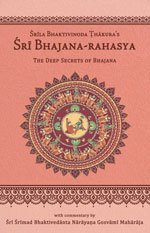Bhajana-Rahasya
by Srila Bhaktivinoda Thakura Mahasaya | 2010 | 123,965 words
The Bhajana-rahasya Text 9, English translation, including commentary (vritti). The Bhajana-rahasya is a compilation of verses describing the mercy of the eight pairs of names (Yugala-nama) of the Maha-mantra. This is text 9 belonging to the chapter “Ashtama-yama-sadhana (Ratri-lila–prema-bhajana sambhoga)” representing from midnight to three-and-a-half praharas of the night: approximately 00.00 a.m.–3.30 a.m.
Text 9
Firm faith in vraja-līlā is found in this verse recited by Śrīman Mahāprabhu (from Sāhitya-darpaṇa, quoted in Padyāvalī 382):
यः कौमार-हरः स एव हि वरस् ता एव चैत्र-क्षपास्
ते चोन्मीलित-मालती-सुरभयः प्रौढाः कदम्बानिलाः
सा चैवास्मि तथापि तत्र सुरत-व्यापार-लीला-विधौ
रेवा-रोधसि वेतसी-तरु-तले चेतः समुत्कण्ठतेyaḥ kaumāra-haraḥ sa eva hi varas tā eva caitra-kṣapās
te conmīlita-mālatī-surabhayaḥ prauḍhāḥ kadambānilāḥ
sā caivāsmi tathāpi tatra surata-vyāpāra-līlā-vidhau
revā-rodhasi vetasī-taru-tale cetaḥ samutkaṇṭhateO friend, that beautiful one who stole my heart in my youth is now here. These are also the same pleasant nights of the month of Caitra, with the same fragrance of blossoming mālatī flowers and the same cool, gentle, fragrant breeze from the kadamba trees. I am also the same; my beloved, too. Nonetheless, my mind is eager for amorous play at the foot of the vetasī tree on the bank of the river Revā.
कौमारे भजिनु यारे सेइ एबे वर
सेइ त’ वसन्त-निशि सुरभि-प्रवरkaumāre bhajinu yāre sei ebe vara
sei ta’ vasanta-niśi surabhi-pravaraसेइ नीप, सेइ आमि, संयोग ताहाइ
तथापि से रेवा-तट सुख नाहि पाइsei nīpa, sei āmi, saṃyoga tāhāi
tathāpi se revā-taṭa sukha nāhi pāi
Commentary: Bhajana-rahasya-vṛtti:
Śrīman Mahāprabhu would recite this verse while dancing in front of Śrī Jagannātha’s chariot. At that time, He was immersed in the transcendental sentiments of Śrī Rādhā, considering Himself to be Rādhā and Śrī Jagannātha to be Vrajendranandana Śyāmasundara. He was feeling that They were meeting each other at Kurukṣetra–this was His mood. At Kurukṣetra, Śrī Rādhā could not experience the same happiness She used to feel when meeting Śrī Kṛṣṇa in the solitary nikuñjas of Vṛndāvana. Absorbed in the mood of Rādhā, Mahāprabhu revealed the distress She felt as She spoke to Her sakhī. “O sakhī, I am that same Rādhā and He is that same Kṛṣṇa, and We are now meeting each other again; nonetheless, My mind is eager for Us to meet and sport together in the secluded nikuñjas of Vṛndāvana.”
Śrīman Mahāprabhu expressed His moods through this Text taken from Sāhitya-darpaṇa. It is described there how a young unmarried heroine (nāyikā) became strongly attached to the qualities of a hero (nāyaka) and met with him on the bank of the river Revā. There, her lover took away her innocence. A kumārī, a very young, unmarried girl, naturally has no desire for union. When this desire arises, youth (kaiśora) begins. After some time, that couple got married. Upon the arrival of the month of Caitra, that young wife now remembers that charming, moonlit night in the vetasī-kuñja on the bank of the river Revā, and how the slow, gentle breeze carrying the fragrance of mālatī flowers stimulated their lust and increased their desire for union. Now, however, in the bonds of marriage, they do not have the same eagerness as then, even though there are no obstacles in their meeting. But her mind has gone to that bank of the river Revā, and happy memories have arisen in her heart of her first meeting with the beloved of her life and their amorous play under the vetasī tree.
In this verse, a mundane poet expresses the feelings of mundane lovers, but through it, Mahāprabhu relished the sweetness of transcendental śṛṅgāra-rasa. In worldly poetry, such a union is considered immoral and characterised by rasābhāsa, a mixing of incompatible sentiments, but Śrī Rādhā-Kṛṣṇa’s pastimes are transcen dental, with the supreme sweetness of rasa flowing through them. The meeting of an ordinary couple is controlled by lust (kāma) that arises from illusion. When their lust is fulfilled, their feelings for each other change. On the other hand, in transcendental amorous mellow (śṛṅgāra-rasa ), the nāyaka and the nāyikā have prema for each other. This prema originates from the svarūpa-śakti’s function of hlādinī and saṃvit, and its purpose is to give pleasure to Kṛṣṇa. In kāma one desires one’s own enjoyment, but in prema one aims for Kṛṣṇa’s happiness.
This is confirmed in Śrī Caitanya-caritāmṛta (Ādi-līlā 4.165):
आत्मेन्द्रिय-प्रीति-वाञ्छा—तारे बलि ‘काम’
कृष्णेन्द्रिय-प्रीति-इच्छा धरे ‘प्रेम’ नामātmendriya-prīti-vāñchā—tāre bali ‘kāma’
kṛṣṇendriya-prīti-icchā dhare ‘prema’ nāma
Śrī Rādhā’s desire to serve Kṛṣṇa is causeless and perpetual. The birth of a material desire, on the other hand, has a beginning and is therefore subject to ruin. The nāyaka and nāyikā who are tied by marriage have svakīya-bhāva (wedded love). Because they are with each other constantly, the variegatedness of rasa does not manifest in their meeting and the sweetness of rasa also remains concealed. However, the sweetness of a nāyaka and nāyikā’s prema in parakīyabhāva (paramour love) manifests in an extraordinary way because their prema is endowed with an exalted, radiant rasa (samunnataujjvala-rasa). The sweetness of the vraja-devīs’ parakīya-bhāva is unprecedented. Because they do not always occur, their meetings with Kṛṣṇa are precious. Owing to the paramour relationship, their mood is characterised by contrariness, prohibition and secret amorous desires. This bhāva is the wealth of the vraja-devīs only. Its only hero is the crown jewel of rasikas, Vrajendra-nandana Śrī Kṛṣṇa and the crown jewel of all the gopīs is Vṛṣabhānu-nandinī Śrī Rādhā. Śrī Caitanyacaritāmṛta (Ādi-līlā 4.80) states: “bahu kāntā binā nahe rasera ullāsa–without many beloveds, there is no rapture in rasa.” Thus, to fulfil Śrī Kṛṣṇa’s desire to taste paramour love, Śrī Rādhā manifests Herself as many beloveds. This parakīya-bhāva is manifest only in Vraja.
